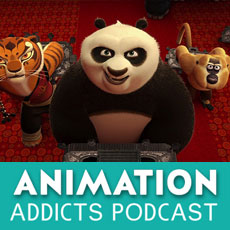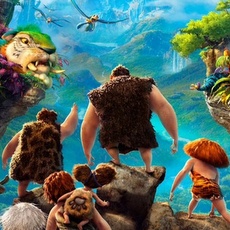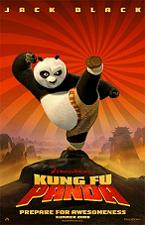 “Come with me, Grasshopper. Today, we are going to talk about the excellence of self and its attainment through hard work. About the best ‘you’ that you can possibly be, to be your own hero. And that you will learn through the story of Po, aka Kung Fu Panda.
“Come with me, Grasshopper. Today, we are going to talk about the excellence of self and its attainment through hard work. About the best ‘you’ that you can possibly be, to be your own hero. And that you will learn through the story of Po, aka Kung Fu Panda.
Enthusiastic, big and a little clumsy, Po was the biggest fan of kung fu around…which doesn’t exactly come in handy while working every day in his family’s noodle shop. When he was unexpectedly chosen to fulfill an ancient prophecy, Po’s dreams became reality and he joined the world of kung fu to study alongside his idols, the legendary Furious Five: Tigress, Crane, Mantis, Viper, and Monkey, under the leadership of their guru, Master Shifu. But before they knew it, the vengeful and treacherous snow leopard Tai Lung was headed their way, and it was up to Po to defend everyone from the oncoming threat. Could he turn his dreams of becoming a kung fu master into reality? Po put his heart into the task, and the unlikely hero ultimately found that his greatest weaknesses turn out to be his greatest strengths.
And to help you delve deeper into this legend, we appealed to two masters who will be, for you, the best of guides: Kung Fu Panda‘s directors themselves, John Stevenson (former story artist and storyboard artist on some of DreamWorks’ most successful animated projects, director of the Father of the Pride animated series and former puppeteer on The Muppet Show) and animator Mark Osborne (director of the multi-awarded, stop-motion short, More). They will initiate you to all the mystical and deepest secrets of this story come to life through the magic of animation.
Now, go, Grasshopper, and find your way…”
John Stevenson [right]: I think what attracted both of us was the martial arts aspect of it. I love martial arts movies, particularly “Wuxia” martial arts films, more than the contemporary Bruce Lee type of films because of the magical, mystical lands and some heroism, where people do great heroic deeds. So, we wanted to try to make a real martial arts movie just using animation, and make a funny one but because of funny characters. We didn’t want to make a parody of the genre.
Mark Osborne[right, below]: I think what attracted me was not only the chance to do an animated kung fu film, which I thought was perfectly right and ready thanks to the latest technology, that tackles such a big, epic genre, and try to do justice. But also, for me, it was a great opportunity to collaborate with Jack Black, whom I’m a huge fan of, and it just seemed like the perfect vehicle and perfect opportunity to create a real fan-boy character, like the most extreme fan-boy ever seen on film, and allow that fan-boy to become the hero of the film. That’s a great, great storytelling opportunity.
MO: Sometimes good, sometimes not good! It was a long, long road, but we set at the beginning that we wanted to really pull ahead together and make the best version of the movie we could by teaming up, as opposed to being in conflict. I think at times, the conflict helps make the film stronger and at times, it was really good someone else to share the pressure. But for the most part, it was a very rewarding experience. We get along great, now!
JS: Basically, the way we would divide the work, the most effective way of handling things was that I ended up following through from art through lighting and final color. In the afternoon, I would go off to work with our writing team and Mark would work with the animators because it’s his background.
MO: Yes, I spent most of my time working with the animation team and working very closely with Dan Wagner, our head of animation, and Rodolphe Guenoden, our fight choreographer, who is also a fantastic animator and supervising animator on our show. That became how we put things up for the most part, but in every aspect of the film, we collaborated very closely because we knew that the only way we were gonna make something that was really solid was in keeping a very opened dialog in every occasion in order to make the same movie together as opposed to do separate things.
JS: Whatever disagreement Mark and I would have, we wanted to resolve that between ourselves in order to present always just one singular approach to the film to the crew.
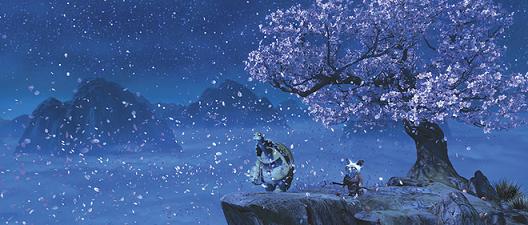
AV: Unlike most of DreamWorks’ animated films, Kung Fu Panda has a certain timeless quality.
JS: That was a very easy choice because that’s a choice that the film made for itself. We didn’t want to be Shrek. We were just interested in trying to to make a real martial arts movie and that would have been a mistake if we would have put some cultural references from our world in that movie that was self-contained, that would have been against the very thing that we wanted to do with the subject in the first place, to make it a mystic story.
MO: It was definitely difficult but I have to say that the Studio absolutely supported our wanting to do something different and our desire to do something different because they could see that there was a lot of value in that, and the Studio wanted to diversify. We were at a period of time when the Studio was really experimenting in different directions. So, for us, in the first half of our exploration on this project, it was sort of like: “let’s see if we can do these different things”.
JS: There was a period of time when we hadn’t all the answers and the things weren’t coming together. But once we knew that the characters were going to be appealing, the story was gonna be solid, the work on the film was gonna be good, when our vision of the film was going to work, they couldn’t have been more supportive on us!
MO: And we wanted to focus on character and there were certain things in matter of jokes we wanted to stay away from and the crew was very proud of that!
JS: The same, there are no pop songs in the movie. We always wanted to have an orchestral score with no pop-culture references.

AV: Kung Fu Panda was a challenge in itself in matter of animation. Can you tell me about that?
MO: The biggest challenge of all was the kung fu. Since we had “kung fu” in our title, and since we were all inspired by the great kung fu films and martial arts graphics, we were all looking at those films and we knew we needed to top them as possible, or at least do something a little bit different and we certainly didn’t want to deliver less. We set our bars pretty high. So, what we explored initially was try to figure out how we could maximize on our animal characters and maximize on the animated world. I think it wasn’t just the animation but it was very aspect of the filmmaking, the camera, the lighting, everything that helps to make our fights be as stylistically similar to those movies but done in animation, with all the technology behind the animated characters that really helped create the ability for our animators to do something that had never been seen before. So, we maximized on their animated abilities and their animal characteristics. It’s not like you would see that there’s some wire work like we can see sometimes in live-action kung fu stuff. So, for us, it was a way to actually perfect kung fu and get all this physicality actually correct. That was the biggest challenge for us, because we wanted our kung fu to be as grounded as possible, and all the acting in this movie as grounded as possible, so that people couldn’t say that it’s animation, so we could do anything. We really wanted to feel the weight of these characters, that people believe what they see.
AV: Your crew was really international. Do you consider it a way to helping be different, as you say?
JS: DreamWorks is multi-national. We’ve got technicians from all over the world, from Europe, Asia, Africa, India… The place is a home for the best possible talents in the world whatever country they might be from. I’m English, you know. So, our crew was a very big mix of international artists in all aspects of the production, from animation to art department or the technical department. Nicolas Marlet, for example, is one of the most innovative character designer I’ve ever seen and I just really wanted him to have a chance to design a whole movie.
MO: I think we had a very collaborative process in our project and when it came to working with the animation team, everybody worked together, everybody gave feedback, threw out ideas. There were different sensibilities there, sensibilities from all the different countries represented. So, our animation team was kind of the United Nations of Animation!
JS: It’s a mix of people who have great talents but who are slightly different culturally from people coming from America, and that pushes everybody in a kind of a melting-pot that has artists with a very strong background and vision. What comes up from that is something much stronger.
MO: Take the French school for example. We had a couple of French artists coming just right out of school and that had a major influence on the film, with a more subtle approach to the acting and more sophisticated approach to doing less with the characters and trying to restrain as much as possible. That was something that came from our French animators.
AV: You also appealed to Daniel D. Gregoire, a live-action artist, and brought him in to do some pre-viz on the film, which is a rather unusual way to proceed. Can you tell me about that?
JS: As I said, the biggest challenge for the movie, artistically and technically, was how our action scenes be different, how they stand out from other animated films or just compete with the big summer blockbusters. So, that first translation from 2D storyboards into three dimensions was very critical. We also didn’t want the film to look like an animated movie; we wanted it to feel like a live action film in photography and technique. Daniel Gregoire had an immense experience in pre-viz on a lot of huge movies like the Star Wars films and Spielberg’s War of the Worlds. So, we started working with him on our first action sequence which is the prison break from Tai-Lung. We knew it had to set the bar for what our action would be and also it had to help establish how we wanted to do it. So, Dan came in and he started working with some guys from our layout department which is where we do our photography on our movie, and one of those guys was named Gary Lee. He, working with Dan, helped basically translate the storyboards and plus them and add things that you wouldn’t see with a storyboard camera. It was incredibly helpful in that scene, which was a six minute sequence that we cut in half because it was too big and too expensive, since it generated a ton of ideas and helped figure out technically how all this stuff that was made of drawings was actually possible to do in CG. The system that we use for our layouts on our film is very good for certain things, but it’s not particularly quick. So, one of the benefits of the pre-viz thing was that they could generate lots of ideas, of possibilities quickly and helped us take more quickly our decisions since we knew that they were gonna work. So, it was a very critical and useful step for us.
MO: For us, it was an extension of story more than anything. It was as exploratory as our story artists are when they’re doing their drawings in 2D but it allowed us to be in the physical space and to maximize on the physical environment. I think that a huge step forward for us in story in figuring out what was possible, what we can do differently than other animated films from the past and where we can go bigger. It was a similar situation that they had been in live action in the past, when they were given like a paragraph, a car chase or whatever, and they had to throw ideas based on the set that had been designed. So, it was an easy step for us, and a very liberating process.
JS: Because, conventionally, you can go straight from story department, storyboards and animatic reel into layout, which is where we set camera. But that didn’t give very much room for experimentation in layout, and it made things a little complex in big action scenes. So, adding that extra step just gave us the freedom to quickly experiment angles and variations and to go into production with the very best choices.

AV: You mentioned 2D, and there is indeed a traditionally hand-drawn animated sequence, realized by James Baxter, that opens the film. Can you tell me about that unexpected association of 2D and 3D within the same movie?
JS: I thought it would be a big fun to have a 2D sequence in a 3D movie.
MO: And being “unexpected” was definitely the intention!
JS: Starting the movie with something that would hopefully surprise people because they would expect to see a whole CG film was something fun. We love 2D. And this sequence appeals to us. It is more graphically stylized than the standard look of 2D animated feature. We have a more graphic sensibility and “anime” was of a huge influence.
MO: So, it was a tip of the hat, but it also was a great way for us to show the interior life of the character and the contrast between his dream-life and his reality. I think that, when you see this character go from 2D to 3D, you pretty much understand everything you need to know about that character and his internal conflict. So, for us, it was an exciting way to visually and stylistically communicate a ton of story really economically. We’re always looking for visual ways to tell stories instead of lots of writing and talking. So, we used every tool around us to communicate that story.
JS: We also wanted to have very good end credits because an animated film has very long credit and watching that text on a black screen is kind of boring. So, in order to credit all the people who worked very hard on the movie, we wanted to find something to do that and help advance to story or expand the world. So, we got the idea of using the same graphic 2D style as we began the film with.
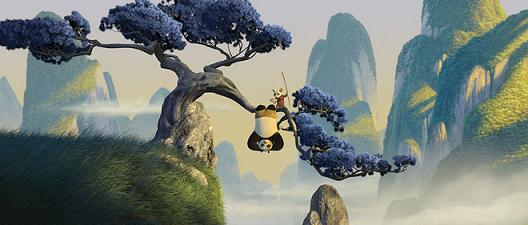
AV: How did you create the musical voice of this universe with composers Hans Zimmer and John Powell?
JS: It was very important to us, as we made a list at the beginning of the movie of things we wanted to do and things we didn’t want to do, was not to have a soundtrack that had contemporary pop songs in it. We wanted a more traditional tool, and an orchestral score. We wanted to make a big, epic movie. So, we knew we wanted a very large scale accompaniment to the film. And we just went so lucky because the very finest composers working today, who had both the ability to create lush musical landscapes, wanted to work together. So, there is a huge, majestic, epic quality to Hans’ music and John’s exciting and innovative ideas. We absolutely love this music!
MO: We told them from the very beginning we wanted our film to be an intimate story about one character, but the backdrop was just epic, with a very formal and martial world. So, for us, it was a strong contrast between the two elements that were the most important to our storytelling, and we wanted them to explore that aspect. So, Hans gave us this huge, epic and beautiful dragon warrior theme, which is very emotional and very sweeping and John was the one who provided us with our very simple, very humble Po music. From both of them, we knew that it would be the perfect marriage because the film was a marriage of extremes. So, it was very smart that they were able to work together. These artists really put their heart into this and that was pretty amazing for us!

AV: For each one of you, what was the most rewarding part of the whole process?
JS: The best part for me was working with actors. It was incredibly interesting because everybody had such a different way of working. Dustin’s working was totally different to Jack’s, etc. They were all fascinating to watch. I learned a lot watching these people. They’re all just great people to be around. They’re smart, funny and hugely talented and to actually get to spend time with Angelina Jolie, Dustin Hoffman, Jack Black and Jackie Chan, and the whole cast, was such a fun time! Animation is so un-spontaneous. It takes so long. But we have that spontaneity in the recording.
MO: And the most fun part for me was working with the animators. I mean, I loved many aspects in the process including the voice recording with the cast, but I think working with the animators and actually going every morning to see the work that they were doing even though it’s a far less spontaneous part of the process, there is such light and vitality that these guys were bringing in very slow motion into the storytelling that was very exciting because there’s so much opportunity in every single gesture and every single moment within the animation to strengthen story and strengthen thematic idea that everyday, it was very exciting to collaborate with those guys and they were open and very collaborative. So, for me, just to see what they were doing and then to be able to work with them and to guide that process was very rewarding! I definitely miss it, now. I go wandering around up there in the hallways of animation even though I don’t have to be there anymore just like: “Hey! Remember me?” It really was a lot of fun!
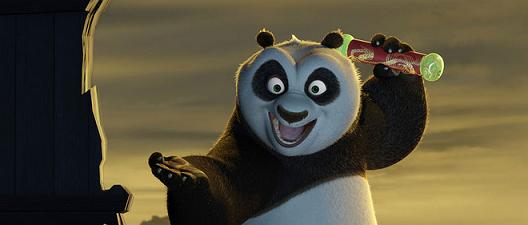
Our gratitude goes to John Stevenson & Mark Osborne, and to David Hail at DreamWorks. All artwork ©Dreamworks L.L.C. All rights reserved.




